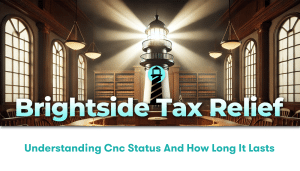Understanding IRS Non Collectible Status
In our breadth of experience as a national tax relief company, Brightside Tax Relief LLC has repeatedly encountered the need to elucidate certain primary facets of tax obligations and statuses. A concept requiring particular definition is the Internal Revenue Service (IRS) Non Collectible Status. Fundamentally, the IRS categorizes a taxpayer as ‘non-collectible’ when they recognize that the individual cannot currently meet their federal tax obligations due to financial hardship.
The Delicate Balance of Your Financial Situation
Accentuating the understanding of IRS Non Collectible Status, it’s crucial to understand that every individual’s financial situation is unique. You may have income, but if your monthly expenses exceed or are equal to your income, after subtracting allowable expenses, the IRS may consider your taxes as currently not collectible. This status effectively means that while the tax debt still exists, the IRS temporarily suspends collection efforts, providing individuals respite during trying financial periods. Yet, it’s necessary to note that the IRS could reinstate tax collection actions if your financial condition improves.
Qualifying for Non Collectible Status
To qualify for IRS Non Collectible Status, there are certain parameters instituted by the IRS, determining candidates’ eligibility. These include:
• A detailed financial statement delivered to the IRS.
• Proof of inability to pay after essential living expenses.
• Evidence of financial hardship.
Proving these parameters requires substantial documentation. Once the IRS reviews these documents, it can then categorize taxpayers into the non-collectible status. For a deep dive and comprehensive understanding, one could visit the IRS website at this authorized link.
Implications of IRS Non Collectible Status
While the attainment of IRS Non Collectible Status could be considered as tax relief, it also holds particular implications. For instance, the IRS can still accrue penalties and interest on the suspended tax obligations. Additionally, the non-collectible status is typically reviewed annually, meaning changes in your financial situation could result in the reinstatement of the status, restarting collection actions. Therefore, it’s vital to understand these accompanying factors when considering this status as an option for tax relief.
How Brightside Tax Relief LLC Can Assist
As an experienced nationwide tax relief company, Brightside Tax Relief LLC has amassed significant expertise in assisting taxpayers navigate challenges tied to their tax obligations. Specifically, with IRS Non Collectible Status, our team can guide taxpayers through the rigorous application process, ensuring that all required documentation is correctly submitted. Furthermore, we ensure our clients understand the comprehensive ramifications of this status and offer advice tailored for every unique financial situation.
Deeper Insights into the IRS Non Collectible Status
To continue our exploration of the IRS Non Collectible Status, it’s essential to address some common misconceptions surrounding this status. Many mistakenly presume this status as an eradication of their tax obligations, however, this is not the case. The debt still exists and continues to accrue interest and penalties during the non-collectible period. Additionally, if there’s no change in the taxpayer’s financial situation after ten years, the IRS, by law has to write off the taxes.
In conclusion, having IRS Non Collectible Status can provide temporary relief for taxpayers experiencing financial hardships. However, they must thoroughly understand the implications and terms surrounding this status. Brightside Tax Relief LLC is here to assist taxpayers to successfully navigate through these complexities, providing professional assistance and tailored advice to ensure that our clients make informed decisions concerning their tax obligations. Knowledge is power and Brightside Tax Relief LLC is dedicated to empowering all taxpayers throughout the United States.




